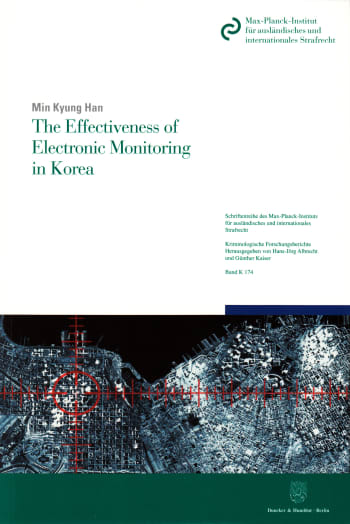Beschreibung
After the »Act on the Electronic Monitoring of Specific Sex Offenders« entered into force in September 2008, the Korean Ministry of Justice began in earnest to implement electronic monitoring as a tool for the enhanced supervision of sex offenders on probation. The Korean electronic monitoring scheme does not aim to reduce costs of incarceration or relieve prison overcrowding but rather seeks to reduce recidivism, promote rehabilitation, and protect the public. Tied to political interests, the use of electronic monitoring has rapidly grown over a short period of time and has become the most prominent program for sex offenders in Korea. Due to its unusual development process and unique characteristics, Korean electronic monitoring practice constitutes a new phase in the development of electronic monitoring.
This study seeks to quantitatively evaluate the effectiveness of electronic monitoring on recidivism among Korean sex offenders. The findings provide a critical evaluation of the »belief« in the effectiveness of electronic monitoring as a means to reduce recidivism (which is often used to justify its application) and, overall, refute the conclusion of some previous electronic monitoring studies that postulated a fixed effect of electronic monitoring, in which electronic monitoring was described as a »treatment« that may have a deterrent effect across all types of offenders and crimes.
Inhaltsübersicht
Chapter 1: Introduction
Chapter 2: Literature review and theory
A systematic review of prior quantitative studies – Meta-analysis of prior quantitative studies – Deterrence or defiance?
Chapter 3: Overview of Electronic Monitoring in Korea
Background: Increase in sex crimes in Korea – A brief history of Electronic Monitoring in Korea – Characteristics of Electronic Monitoring in Korea – The costs of Electronic Monitoring in Korea
Chapter 4: Data and methods
Data – The nature of data – Statistical methods – Definitions of variables
Chapter 5: Does Electronic Monitoring reduce the risk of recidivism? Comparison between Electronic Monitoring and non-Electronic Monitoring groups
The »trick« of recidivism rates – Controlling for nonrandom assignment of Electronic Monitoring – Analyzing the effect of Electronic Monitoring on recidivism
Chapter 6: Is recidivism different from risk levels of Electronic Monitoring subjects? Comparison between low/moderate- and high-risk Electronic Monitoring groups
Classifying sexual offenders according to risk level – Analyzing time to recidivism according to risk level
Chapter 7: Can Electronic Monitoring be an alternative to the preventive detention? Comparison between rehabilitation- and monitoring-oriented Electronic Monitoring groups
Electronic Monitoring that differs in purpose – Controlling for nonrandom assignment of groups – Analyzing time to recidivism according to purposes of Electronic Monitoring
Chapter 8: Conclusion
Main findings – Future directions
Bibliography
Bücher aus denselben Fachgebieten
Kontakt
-
+49 30 / 79 00 06 - 0
-
Bestellinformation
-
Versandkostenfrei innerhalb Deutschlands.
-
Für Kunden aus EU-Ländern verstehen sich unsere Preise inklusive der gesetzlichen Mehrwertsteuer und – außer bei digitalen Publikationen – zuzüglich Versandkosten. Für Kunden aus Nicht-EU-Ländern verstehen sich unsere Preise als mehrwertsteuerfrei und – außer bei digitalen Publikationen – zuzüglich Versandkosten.
-
-
Newsletter































